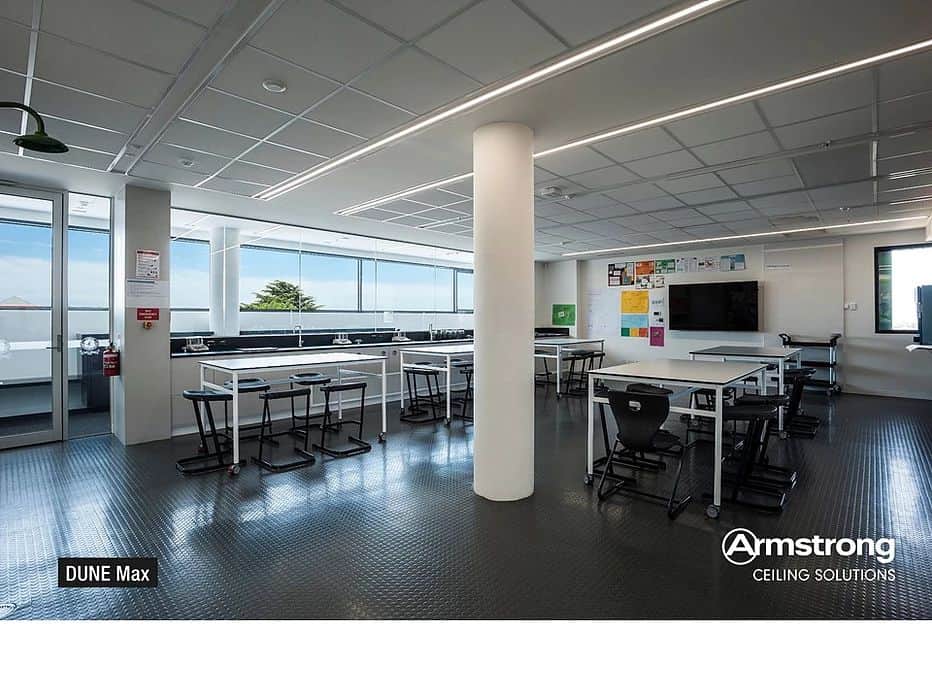
Soft ceiling tiles are those tiles that you see in drop ceilings. They are typically made with a grid system that supposed these ceiling tiles in them. They can be made so the grid will show prominently, or they have styles and designs that cover it up nicely. These tiles have come a long way since the beginning of these systems. They used to carry asbestos in them which acts as amazing insulation. In fact, you can read more about this in our post titled “Do Armstrong ceiling tiles contain asbestos?“. There we go over what asbestos is, why it is not used anymore and other things.
These soft ceiling tiles are great for room acoustics as well as insulating properties. They have varying R factors depending on what style and brand you choose from. Soft ceiling tiles are decorative as well. They are used to bring the ceiling closer and make large commercial buildings more inviting. Ceiling tiles often are white from the factory but can be made into various color options as well.
Drop Ceiling History
These drop ceilings were made popular in the US in the 1960s. However, they have been around since the beginning of the 1800s. In the beginning, they were mostly used in the kitchen and were metal. They were easy to spot as you would see the exposed grid. You might see them in a restaurant and shops as well to make the shop or restaurant more inviting. The size of these tiles varies from 2′ x 2′ or 2′ and longer.
Well, it is true that dropping the ceiling will leave less space to heat and cool there are other factors to consider as well. To fully understand what a drop ceiling will do for you, you will need to understand several factors:
- The distance from the original ceiling and the drop ceiling. And, the air movement that is going to occur above the drop ceiling as well as below it. For example, if there are large doors that are constantly opening to the cold or hot outside, this will have a negative effect on the area.
- The R-value of the original ceiling and roof, as well as the walls, will have a direct impact on the R-value of the room. Some ceiling tiles come with their own R factor as well. This can be very important in determining what benefit you might see by using a drop ceiling.
Factors that Affect Insulation Properties of Drop Ceilings
- How the space above the drop ceiling is used. Often this can be used as a cold air return and thus providing a lot of moving air. This can have a positive or negative effect on the heating and cooling system.
- How the air cavity between the two ceilings is constructed. For example, if there is a hole going into a cold warehouse or an opening to the outside, this should be addressed to ensure good insulation.
- HVAC is key here in determining what needs to be done to get the best results. Sometimes the HVAC uses the blank space as a part of the heating and cooling system.
- The condition of the panels is very important too. Should you have a broken panel or a panel that is cracked this can damage the entire flow of the system and should be repaired immediately.
- Care should be taken when installing such a system. Ensure that everything fits together properly and there aren’t any leaking spots that will help with the insulation of the room.
Materials used for Drop Ceilings
There are several types of materials that are used to make these ceiling panels and that also affects the R-factor. Materials such as drywall are not as insulating, and fiberglass and the thickness is also an important factor when it comes to insulating.
Effects that a Suspended ceiling has on the R-Value

Because you are lowering the ceiling you are lowering the area that you will have to heat and cool. This just makes sense that it will cost less because there is less space. But, there are things that you can do to improve the insulation of that suspended ceiling. You can even add insulation above it. Just ensure that the cables and grid system is built to hold the extra weight of the insulation. This insulation comes in a variety of choices, just as insulation for your home’s walls. These choices offer different R-factors as well as cost options.
You can also add insulation to the inside of the building. This allows you to insulate the walls that may be more exposed to cooler or warmer elements. For example, a factory with attached offices could benefit from this inside insulation. The office walls should have insulation to the factory as most times factories do not have heat and cooling systems that are comparable to that of an office. This will help keep the office at a comfortable temperature without breaking the bank.
Other things that can be done to improve R-factor
There are sealing tiles as well. These tiles have a gasket or use tape to seal them off and provide a much better barrier than that of just a normal drop ceiling. This ensures that the tile seals off the drop ceiling from the upper ceiling. This provides, obviously, better insulation as well.
Imagine 100’s and 100’s of feet of ceiling tile. This is going to have a large impact on the way the building’s HVAC systems work. In this drop ceiling, you can also include light panels that will provide a nice soft glow to the room. These panels do not provide as much of an insulating factor as the solid panels. However, if they are insulted correctly, they will block out the air from above.
When looking at drop ceilings you should have an HVAC company involved as well if insulation is something you are considering. They can provide you with feedback on what type of ceiling you should consider and materials. The grid can be beefed up if needed to provide the needed support for the additional weight of the grid as well. However, if you are looking to improve the insulation of your drop ceiling that you currently have, you will need to work within the parameters of the existing ceiling.
Click here to find out more on “What are fibre tiles made from?”



